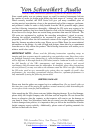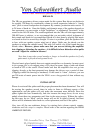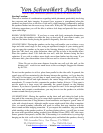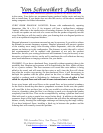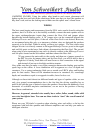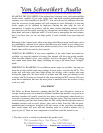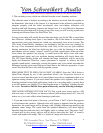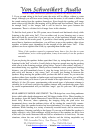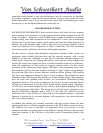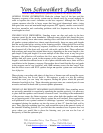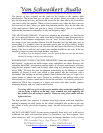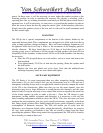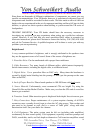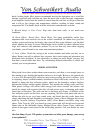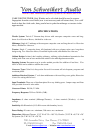
Von Schweikert Audio
930 Armorlite Drive, San Marcos, CA 92069
Ph (760)410-1650 Fax (760)410-1655
E-mail:albertvonn@aol.com
World Class Reference Speaker Systems for Music and Film
~ Website:www.vonschweikert.com
12
The physics of bass response are the same for the listener or the speaker when
interchanged. That means that you can place one speaker where you wish to sit, then
play the repeating bass line, and then walk around on the other side of the room where
you want to place the speakers. When you find a neutral zone, where the bass is not too
loud nor too soft, that’s where you place that particular speaker. Next, do the other side
in the same manner. Make sure you use a variety of recordings, since it is possible to
optimize the placement accidentally for only one frequency range!
TOO MUCH BASS OVERALL: If you have optimized the placement, yet find that the
bass is too powerful due to a very small room and/or mandatory corner placement due to
the nature of the furniture arrangement, you can “tune” the bass balance. If the entire
bass range is too loud, purchase Dacron Polyfill from the local five and dime store or
sewing shop. It is synthetic cotton in appearance and is used for pillow stuffing. Simply
place a handful of the Dacron in each vent tube; this will lower the efficiency of the vent
tuning. If the bass is still too loud overall, place another handful in each vent. If the low
frequency range has come into proper balance, stop there.
If you have lost the deepest octave, you can push the Dacron into the enclosure
instead of leaving it in the vent tube proper.
BASS RESPONSE TUNING FOR TUBE AMPLIFIERS: Since tube amplifiers have “air
and liquidity” in the mid and treble ranges, many audiophiles use them. However, the
saturation, back EMF, and transient response delays of all output transformers will cause
sluggish bass response which can be heard when using any speaker that has response
below 50Hz. The deep bass can be tightened considerably by the addition of several
handfuls of Dacron in each vent, which is then pushed into the enclosure with a
broomstick. The stuffing can be done gradually, but if the bass become ‘too’ tight, it is a
simple matter to remove the excess Dacron by reaching in and pulling some of the
Dacron back out. (It takes a small hand to fit into the vent tube). It is entirely possible to
tighten the VR-4s bass response to a degree not heard with other speaker systems,
comparing directly with very small sealed woofers.
Try using solid core wire on the woofer modules when using tube amplifiers if
you are trying to tighten up the bass, since stranded wire will emphasize the
bass fullness you are trying to equalize. However, using silver cables will also
tighten the bass.
The best possible bass response is obtained from high current solid-state amplifiers,
making bi-amping the ideal choice for the critical audiophile who wishes to have the
best sound in every part of the frequency range. See the section above regarding bi-
amping.
LACK OF APPARENT BASS: In some rooms, especially those with ‘soft’ walls such as
wallboard over studs, and open floor plans, it is possible to ‘lose’ bass response. Also,
when sitting in a ‘null’, it is possible to perceive, incorrectly, that there is a loss of bass



